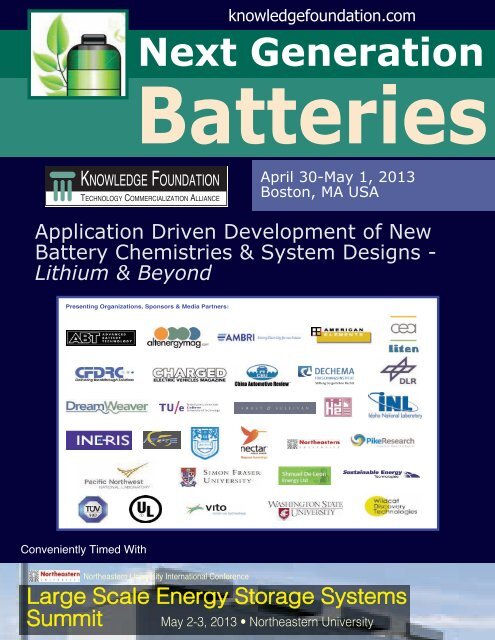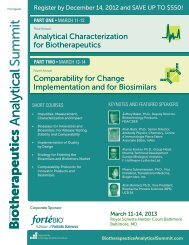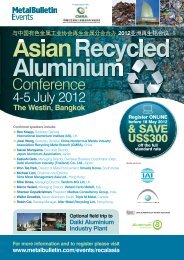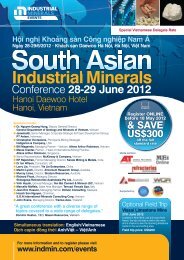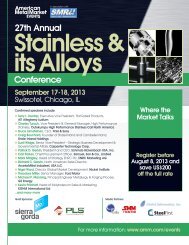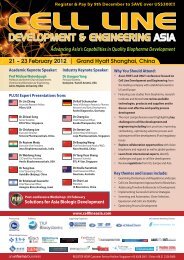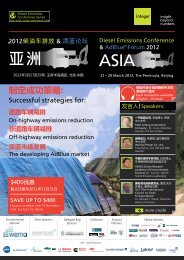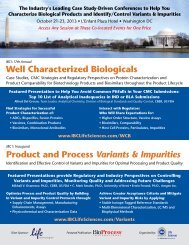PRINT Main Brochure
PRINT Main Brochure
PRINT Main Brochure
You also want an ePaper? Increase the reach of your titles
YUMPU automatically turns print PDFs into web optimized ePapers that Google loves.
Next GenerationBatteriesConference AgendaTuesday, April 30, 20138:00 Registration, Exhibit Viewing/Poster Setup, Coffeeand Pastries8:50 Organizer’s Welcome and Opening Remarks9:00 Electrochemical Energy StorageDevelopment at PNNLVincent Sprenkle, PhD, Chief Engineer -Electrochemical Energy Storage and Conversion,Pacific Northwest National LaboratoryThe environmental concerns and constraints of the fossil fuels,combined with energy security concerns, have spurredincreasing interest in higher efficiencies systems and renewableenergy technologies. The transition from fossil based resourcesto renewable cannot be realized without effective energystorage technology. The DOE Office of Energy Storage Programat Pacific Northwest National Laboratory (PNNL) is focused onthe development of cost effective energy storage technologiesto meet future energy needs. Among the most promisingstorage technologies for the stationary applications areelectrochemical storage technologies including redox flowbatteries and Na-metal battery, and Na-ion technologies.9:30 Microfluidic Redox BatteryErik Kjeang, PhD, PEng, Assistant Professor,Mechatronic Systems Engineering, School ofEngineering Science, Simon Fraser University,CanadaA rechargeable microfluidic redox battery is demonstrated thatcan operate without a membrane to separate the two half-cells.Developed as a low-cost power source for mass-producedwireless sensors and electronics, this transformative flow batteryconcept can be integrated on-chip and is compatible with lowcostmaterials and inexpensive micromachining and microfabricationmethods. The layout, functionality, and performanceof the proof-of-concept device will be discussed.10:00 Liquid Metal Batteries for Grid ScaleElectricity StorageDavid Bradwell, CTO, Ambri, Inc.Abstract is not available at time of publishing. Please visitwww.KnowledgeFoundation.com for the latest updates on theProgram.10:30 Networking Refreshment Break, Exhibit/PosterViewing11:00 Bio-Battery: A Novel Micropower Source forPortable ElectronicsSameer Singhal, Director, Biomedical & EnergyTechnologies, CFD Research Corp.CFDRC is developing an enzyme catalyzed power source, Bio-Battery, which generates energy from readily-available fuels(sugars, alcohols, etc.). The Bio-Battery can power applicationsfor both military and civilian needs. Additionally applications areseen in biomedical devices, where power generation fromphysiological fluids could lead to improved implantable medicaldevices. The technology’s benefits include high energy density,safety, low-cost and renewable biocatalysts, and logisticallyfavorablefuels. A mature prototype has been demonstrated.11:30 Investigation of Graphite-Based Electrodesfor Vanadium Flow CellAlessandra Di Blasi, CNR-Istituto di TecnologieAvanzate per l’Energia “Nicola Giordano”(ITAE), Italy*Several graphite-based electrodes are investigated for vanadiumflow battery applications. These materials are characterized bothas-received and after chemical or electrochemical treatments.The chemical treatment causes a cleaning of the electrodesurface from adsorbed oxygen species or labile bondedfunctional groups in highly graphitic samples. Whereas,carbonaceous materials characterized by smaller graphiticdomains or a higher degree of amorphous carbon show anincrease of oxygen functional groups upon chemical andelectrochemical pre-treatments. An increase of oxygen speciescontent on the surface above 5 % causes a decrease ofelectrochemical performance determined by an increase ofohmic and charge transfer resistance. *In collaboration with:O.Di Blasi, N.Briguglio, A.S.Aricò, D.Sebastián, M.J.Lázaro,G.Monforte, V.Antonucci12:00 Printed Thin Film Li-Ion BatteriesHélène Rouault, PhD, R&D Project Manager inAdvanced Batteries, French Alternative Energiesand Atomic Energy Commission (CEA), France;Julio Abusleme, R&D Project Manager, SolvayS.A., BelgiumMulti-applicative smart tags, cards appear to be the nextgeneration of devices, which could revolutionize the electroniccommerce and smart communication, access, control in verylarge domain of applications (transport, ambient intelligence,industrial implant). Such products need embedded 2D powersources, offering the highest energy density. Basically madefrom inks, the lithium-ion technology is so really well adapted tobe designed in such printed configuration. Consequently CEAand Solvay jointly have engaged a large program ofdevelopment on innovative thin film and printable lithium-ionbatteries, using monolithic structure printed from specific PVDFbased inks, making them conformable and flexible.12:30 Luncheon Sponsored by the KnowledgeFoundation Membership Program2:00 Advances toward Inorganic Li-Ion CellChemistriesKevin L. Gering, PhD, Technical ProgramManager, Applied Battery Research, IdahoNational LaboratorySafety and longevity of lithium-ion batteries can benefit by anoverall reduction of carbon within the cell chemistry. Forexample, conventional organic carbonate solvents have lowflash points and are not suitable for operation at 5V, whilecarbon anodes have been shown to trigger the fate of cathodestability under thermal runaway. INL is developing alternativecell materials for electrolytes and electrodes that are resilient at©1998-2013 Knowledge Foundation. Agenda, times and titles of presentations are subject to change. Please visit www.knowledgefoundation.com for the latest Program updates.
Next GenerationBatteriesConference Agendaelevated temperatures, higher voltages, and offer distinctopportunities to custom-engineer attributes of batteryperformance and life.2:30 Discovery of a >250 mAh/g, Non-LayeredOxide Cathode Material for Lithium-IonBatteriesSteven Kaye, PhD, Chief Scientific Officer,Wildcat Discovery TechnologiesWildcat Discovery Technologies has developed a high throughputsynthesis and screening platform for battery materials. Wildcat’ssystem produces materials in bulk form, enabling evaluation of itsproperties in a standard cell configuration. This allows simultaneousoptimization of all aspects of the cell, including the active materials,binders, separator, electrolyte and additives. Wildcat is using thishigh throughput system to develop new electrode and electrolytematerials for a variety of battery types (primary, secondary,aqueous, non-aqueous). In this talk, I will discuss our latestdiscovery, a non-layered oxide cathode with capacity >250 mAh/g,irreversible capacity
Next GenerationBatteriesConference Agendarechargeable battery technologies although it is generallyrecognized that their progress lagged behind that ofmicroelectronics. The natural question is whether we canformulate a counterpart of Moore’s Law for guiding the rapidprogress of rechargeable battery technologies. In this talk I willprovide a brief overview of rechargeable batteries, with anemphasis on recent advances in materials and engineering ofpractical batteries, particularly lithium-ion batteries and thosebeyond today’s Li-ions,. The energy densities of Li-ion batterieshave increased from about 200 Wh/liter in the middle nineteennineties to more than 600 Wh/liter today. The prospect forcreating a counterpart of Moore’s Law for rechargeable batteriesdepends on gaining a clear understanding of the factorsgoverning the energy, power and rechargeability of practicalbatteries. Modest advances in energy density and significantadvances in power density can be made through batteryengineering. On the other hand, significant advances in energydensity and cycle life rest with discovering new electrodematerials and optimally engineering them. A benchmark law maybe formulated to guide advances in power density whereas thediscovery of new materials capable of ultrahigh energy densitypractical batteries may just hinge on serendipity in researchguided by electrochemical principles.9:15 High Specific Energy Lithium Cells forAerospace ApplicationsFlorence Fusalba, PhD, Batteries ProgramManager, Laboratory for Innovation in NewEnergy Technologies and Nanomaterials(LITEN), French Atomic Energy Commission(CEA), FranceAmong various parameters, high specific energy is the mostimportant criteria for aerospace applications. A breakthrough isexpected in this domain to be able to prepare batteries with thekey driver for application of at least 250Wh/kg BoL at cell level.Exploring a number of possibilities in the quest for moreenvironmentally friendly aircrafts or to sustain satelliterequirements, operating with high reliability & efficiency, underspecific environment including large temperature range, themajor challenge remains demonstrating sufficient cycle life forsuch high energy cells.9:45 Development of a PVA/TiO2 Polymer/GelMembrane for the Zinc/Air BatteryJean-Francois Drillet, Research Scientist,DECHEMA Research Institute, GermanyTiO 2modified PVA membranes were synthesized and tested in aprimary cell with a zinc paste and a MnO 2air electrode. Firstmeasurements in a button cell show an enhancement of the cellcapacity of about 6-10% compared to that of commercial cellsequipped with a separator. At 10 mA discharge current, acapacity of 660 mAh g-1 zinc has been measured. By using amembrane with a thickness of about 70-150 µm, an increase ofabout 25mV in cell voltage was observed at 20 mA. Theexcellent performances were attributed to the high ionicconductivity of the polymer/gel membrane and to an optimalelectrolyte management at the membrane-electrode interface.register onlineknowledgefoundation.com10:15 High Energy Flexible Thin Solid State Li-ionBatteries: Nanostructured Electrodes andElectrolyte MaterialsElena Shembel, PhD, CEO and President, EnerizeCorporationThin film flexible solid state Li-ion batteries based on proprietaryinorganic solid electrolyte, high energy nanostructured binder-freeSi-graphite anode, and binder-free spinel based cathode.Synergetic effect of technology and equipment for thin filmdeposition reduces costs, increases productivity of the batteryfabrication, and provides reliability and high performance ofbatteries. Solid inorganic electrolyte enables to use batteries fromminus 10°C and up to plus 250°C. Areas of applications with highbenefits include oil & gas drilling, hot environment, vehicle runninguphill, deep mining, aerospace. Enerize has 3 US patents and 3 USpatent applications in the area of thin film solid state batteries.10:45 Networking Refreshment Break, Exhibit/PosterViewing11:15 The Power Demand GapMouli Ramani, Vice President, LilliputianSystems, Inc.With devices using more power than ever, especially smartphones,lithium ion batteries just cannot keep up with the power demand.Lilliputian Systems has developed a solid oxide fuel cell designed tosolve this “demand gap” and charge any device that subscribes tothe USB standard. The charger can provide up to two weeks ofpower for smartphones, GPS, cameras and many other consumerelectronics devices on a single power cartridge.11:45 ZEBRA Battery system for range extenderarchitecture in a Fuel Cell Hybrid VehicleLaura Andaloro, CNR-Istituto di TecnologieAvanzate per l’Energia “Nicola Giordano” (ITAE),Italy*The range extender architecture represent an advantageouschoice, both from a technical and economic point of view, for thehybridization of stationary and transport systems that use fuelcell and batteries systems. With reference to this configurationthe CNR TAE Institute is involved in a national project regardingthe development of a hybrid electric city bus based on a rangeextender architecture. Six ZEBRA batteries (Zero EmissionBattery Research Activities) recharge a reduced size (ratedpower 5 kW) of PEM fuel cell system (low investment cost)obtaining the increase of 30% of the range with respect the pureelectric version of the vehicle. Present work intends to relate theconfiguration of batteries and fuel cell system realized for thecity bus project. *In collaboration with: F.Sergi, G.Napoli,N.Randazzo, V.Antonucci12:15 Novel 3D-Microbatteries: Modeling andDesignDmitri L. Danilov, PhD, Researcher, Departmentof Chemical Engineering and Chemistry,Eindhoven University of Technology, TheNetherlandsAll-solid-state micro-batteries (MB) are in the focus of modern©1998-2013 Knowledge Foundation. Agenda, times and titles of presentations are subject to change. Please visit www.knowledgefoundation.com for the latest Program updates.
Next GenerationBatteriesConference Agendabattery research. The new concept of 3D integrated MB is basedon the etching of deep 3D-structures into a Si substrate,increasing the effective surface area. New possibilities exist toincrease the energy density by applying novel Li-storagematerials. Mathematical modeling provides insight into thefunctioning of all-solid state Li-ion batteries. In particularcharge/discharge profiles of 3D-MB with prospective Si anodeare calculated, energy and power limitations of complete deviceas function of design parameters are studied. 3D integrationreduces the current density and improves electrode andelectrolyte kinetics. It leads to considerable gain in batteryperformance.12:45 Lunch on Your Own2:00 Perpetual Motion using Lithium Air BatteryTechnologyNeil Chertoff, CEO, 27th Century Technologies,Inc.The presentation will include discussing Lithium Air BatteryChemistry as compared to our current day Lithium-ionChemistry. The advantages to the user of this chemistry whenusing power tools, laptops, mobile radios, cell phones, tabletsand of course Electric Vehicles. We will discuss how we wereable to develop the Perpetual Motion Battery for everydayapplications and how it will affect all of our lives. In addition wewill explain how our climate and the reduction of CO 2will benefitour environment form this reduction in emissions. The need toreduce our dependence of foreign oil and the benefit in reducingthe cost of maintenance and operation of our cars and trucks willbe discussed. We will have working prototypes on some of theproducts we will be manufacturing for fiscal 2013.2:30 On The Road of Harmonizing BatteriesSafety StandardsChritian Michot, INERIS, France*In order to promote the introduction of EVs into the internationalmarket, the EU, USA and Japan agreed in November 2011 tocooperate on development of EV safety global technicalregulations. For that reason, in September 2012, UL LLC andINERIS initiated a cooperative agreement with the goal to focuson ways to reduce inconsistencies between Li-ion EV batterysafety standards. A comprehensive review of mechanical,electrical and environmental tests is provided withrecommendations for harmonization of test conditions and formutual recognition of test results are identified. *In collaborationwith: Underwriters Laboratories3:00 Characterization of Automotive Li-Ion Cellsin Relation to Their Material PropertiesBased on the Test StandardsGrietus Mulder, Researcher, VITO Unit EnergyTechnology, Belgium*The presentation that VITO proposes has two components thatdepend on each other: the methods to characterize automotive(Li-ion) battery cells; test results with a translation to materialproperties and shape. Six test standards exist for automotivecells and battery systems. These standards have been defined toensure that battery systems can cope with specific tasks likepowering an electric vehicle or a power assisted hybrid electricvehicle. However, to compare cells with each other, the testmethodologies in the standards have to be harmonized and beexecuted at clear C-rates. An enhanced test methodology hasbeen constructed, consisting of 5 tests. Then 13 cells with 5species each have been tested covering a wide range ofmaterials, shapes and capacities. The test results can be relatedto material and shape with help of graphs. The test results canalso be related to physical relations. Depicting physicalrelationships behind cell properties can reveal effects that areinvisible from the absolute value of the property. Clear relationsto cell (cathode) chemistry can be found for voltage shape,voltage range, and energy density. The influence of cell shapeand chemistry can be discerned in the test results ontemperature, efficiency, resistance and charge behavior.However, the knowhow of the manufacturer appears often to bemore deciding. *In collaboration with: Bart Mantels, VITO;Noshin Omar, VUB3:30 Networking Refreshment Break, Exhibit/PosterViewing4:00 A Data Based Analysis of Overcharge Abuseof Lithium Ion CellsErik J. Spek, PEng, MASc, Chief Engineer, TÜVSÜD CanadaTÜV SÜD, a global third party provider of product testing andcertification services, has performed SAE, USABC and otherabuse tests on hundreds of large format lithium ion cells togauge the robustness of cells. This presentation covers theovercharge behavior of over 160 cells of different formats,chemistries, capacities, test environments and test parameters.All of the data is from tests performed by TÜV SÜD since 2010.The data has been organized to show how this population ofcells has responded in terms of Hazard Severity Level (HSL) andmaximum temperature in relation to capacity, charge rate,physical constraint and other factors.4:30 Grid Connection Challenges for NextGeneration BatteriesBrent Harris, PEng, Vice President, ChiefTechnology Officer, Sustainable EnergyTechnologies Ltd., CanadaAdvances in battery technology combined with the acceleratingdeployment of solar PV and other renewable energy systems onelectricity systems around the world. This presentation willoutline the unique technical and regulatory challenges that mustbe addressed by grid connect power electronics developed forthese applications.5:00 Exhibitors and Sponsors ShowcasePresentations / Selected Oral PosterHighlights5:30 Concluding Remarks, End of Conferenceregister onlineknowledgefoundation.com©1998-2013 Knowledge Foundation. Agenda, times and titles of presentations are subject to change. Please visit www.knowledgefoundation.com for the latest Program updates.


